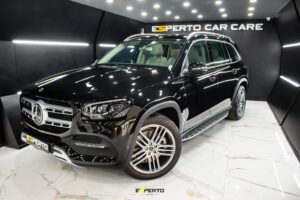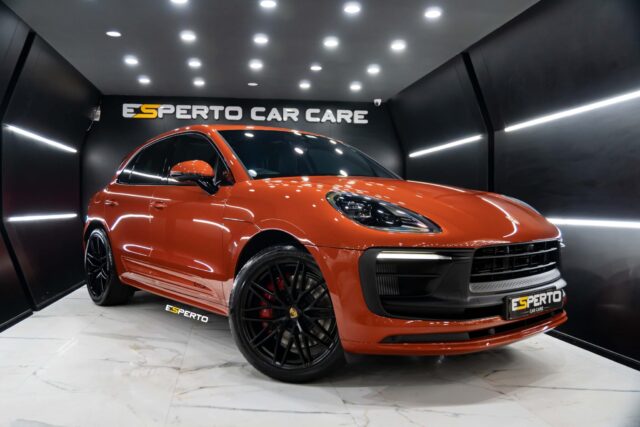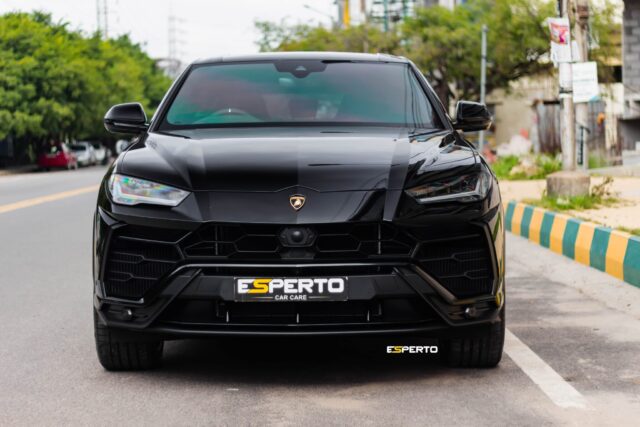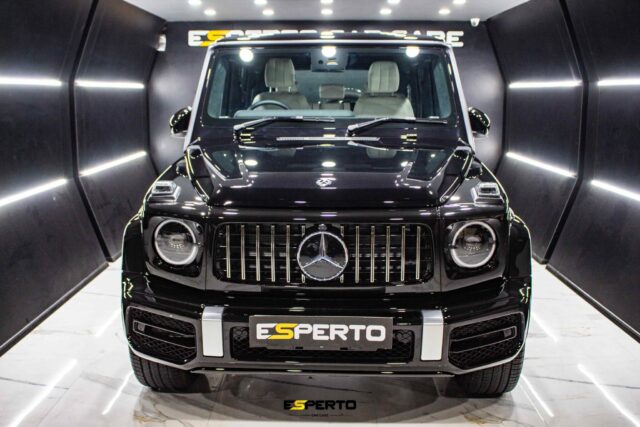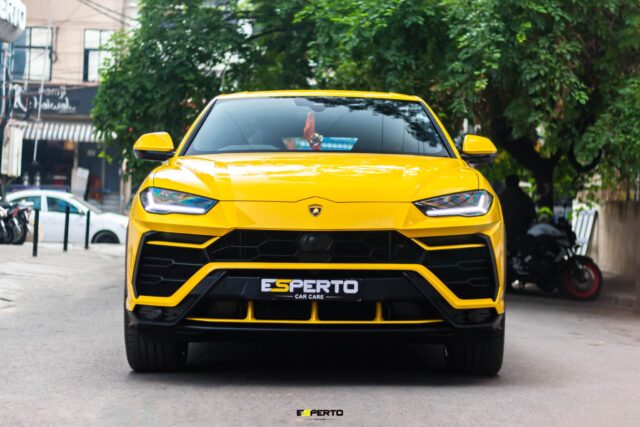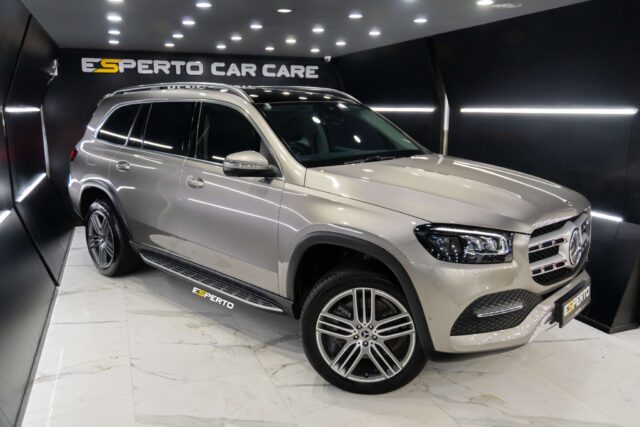Can PPF Stick to Ceramic Coating? Understanding the Compatibility and Benefits
Many car owners wonder, “Will PPF stick to ceramic coating?” This question often arises when they look for ways to protect their vehicle’s paint. The answer is not as straightforward as one might think.
Paint Protection Film (PPF) and ceramic coatings serve similar purposes but function differently.
One interesting fact about this topic is that applying PPF over a ceramic-coated car can enhance the vehicle’s protection level. Our article will guide you through how these two protective measures work together to shield your vehicle from environmental damage and contaminants. Learn more about advanced car paint protection in Coimbatore to keep your vehicle in top condition.
How does PPF differ from ceramic coating?
Paint Protection Film (PPF) and Ceramic Coating serve as two main methods to protect your car paint, but they work in different ways. PPF is a thick, transparent film applied directly to the car’s body.
This layer acts like a shield against rock chips, scratches, and swirl marks. Its self-healing technology allows it to repair itself from minor scratches when exposed to heat. On the other hand, Ceramic Coating is a liquid polymer that bonds with the vehicle’s existing paint to create a protective layer.
This coating forms a protective barrier, causing water and dirt, which makes cleaning your vehicle much easier while adding gloss and shine.
While PPF provides physical protection against external damage, Ceramic Coating offers superior resistance against chemical stains like bird droppings and UV rays.
Understanding Paint Protection Film (PPF)
Paint Protection Film (PPF) is a transparent, thick polyurethane film applied to the surface of your vehicle. This thermoplastic layer works like a shield, guarding the car’s paint against rock chips, scratches, and environmental contaminants.
Its durability guarantees that it can endure the assault from road debris and adverse weather conditions. Car owners appreciate how PPF preserves their vehicle’s appearance while enhancing its resale value.
The self-healing technology in some protection films showcases an advanced level of protection. Minor scratches and swirl marks fade away when exposed to heat. From the sun or engine warmth, they are keeping the car looking newer for longer.
For those seeking superior protection without changing the appearance of their vehicle, PPF provides an excellent solution. It’s thicker than ceramic coatings and offers resistance against mechanical damage while also being easier to wash due to its slick surface properties.
Exploring Ceramic Coating Benefits
After covering the essentials of Paint Protection Film, let’s move on to ceramic coating benefits for your vehicle. Ceramic coating offers a strong layer of protection against various elements.
It creates a hydrophobic surface that repels water, making cleaning your car much easier and more efficient. This water-repelling action means dirt and debris find it more challenging to adhere to your car’s surface, helping it stay cleaner for more extended periods.
Ceramic coatings also improve the gloss and richness of your car’s paint, giving it a constant “just waxed” appearance without the need for regular waxing. Its durability is impressive as well; once applied, ceramic coating can last for years, protecting against UV rays that cause fading over time.
By apply ceramic coating, you protect your paint effectively and maintain your vehicle’s aesthetic appeal.
Comparing PPF vs. Ceramic Coating for Your Car
Transitioning from the advantages of ceramic coatings, we now delve into an insightful comparison between Paint Protection Film (PPF) and Ceramic Coating for your vehicle. This analysis will provide clarity on which option might be most suitable for your car’s protection needs.
| Feature | Paint Protection Film (PPF) | Ceramic Coating |
|---|---|---|
| Primary Benefit | Protects against physical damage like chips, scratches, and stains. | Provides a protective layer against chemical damage, UV rays, and enhances gloss. |
| Composition | Made from thermoplastic urethane film. | Composed of silicon dioxide (SiO2) derived from quartz crystals and other materials. |
| Durability | Can last up to 10 years with proper maintenance. | Typically lasts between 2 to 5 years, depending on the product and maintenance. |
| Self-Healing Technology | Yes, minor scratches can self-heal with heat application. | No, does not have self-healing properties. |
| Protection Level | High level of protection from physical impacts. | High level of protection from chemical impacts and UV exposure. |
| Application | Requires professional installation for best results. | Can be applied professionally or as a DIY, though professional application is recommended for longevity. |
| Cost | Generally more expensive due to the material and labor-intensive installation. | Less expensive than PPF but varies based on brand and quality. |
| Maintenance | Needs regular washing and may require waxing to maintain gloss. | Requires less maintenance, only regular washing and occasional top-up of the coating. |
Both Paint Protection Film and Ceramic Coating provide unique benefits for protecting your vehicle. Your decision should reflect your specific requirements, whether safeguarding against physical abrasions with PPF or maintaining a glossy, protected surface with ceramic coating.
Can You Apply PPF Over a Ceramic Coating?
Absolutely, PPF (Paint Protection Film) can be applied over a ceramic coating on your vehicle. Many vehicle owners and enthusiasts seek superior methods to shield the vehicle’s paint from environmental harm and regular wear.
The application of PPF on a ceramic-coated surface provides an extra defensive layer, merging the advantages of both procedures. Primarily, make sure the ceramic coating is fully set on the vehicle’s surface.
This procedure may take approximately two weeks or more, depending on factors like humidity and temperature.
The crucial point is to involve professionals in the process as they are equipped with the knowledge to prepare the coated surface for the PPF installation correctly. They will purify and potentially lightly polish the ceramic coating to ensure it bonds well with the PPF.
This guarantees enduring durability and effectiveness in safeguarding your car’s paint against rock chips, scratches, and UV rays.
A professionally applied PPF over a ceramic coating boosts protection while preserving the vehicle’s visual appeal.
Adopting these measures amplifies not just gloss but also the hydrophobic characteristics, making your vehicle more straightforward to clean.
Steps to Apply PPF Over Ceramic Coating
Applying Paint Protection Film (PPF) over ceramic coating can provide your vehicle with top-tier protection. This combination enhances both the durability and the aesthetic appeal of Your car’s paint.
- Start with a clean surface. Ensure the car is free from dirt, dust, and contaminants. This involves a deep wash and a clay bar treatment to remove any impurities from the surface impurities.
- Perform paint correction. Address any scratches or imperfections in the paint to prevent them from being sealed under the PPF. This step is vital for achieving a flawless finish.
- Make sure the ceramic coating is fully cured. A freshly applied ceramic coat needs time to harden completely before applying PPF. The curing time can vary but typically ranges from one to three weeks.
- Choose the correct type of PPF. Not all paint protection films are alike; some are specifically designed to adhere better to ceramic-coated surfaces.
- Cut and shape the PPF according to the vehicle’s dimensions. Precise measurements ensure complete coverage without excess material at the edges.
- Use an application solution to position the film. A soapy water solution allows you to slide and adjust the film on car’s surface before it adheres.
- Squeeze out bubbles and wrinkles carefully as you apply pressure, starting from the center and moving outward, ensuring no air pockets are trapped under the film.
- Allow it time to dry thoroughly after application, which could take several hours depending on temperature and humidity levels.
- After applying, avoid washing your car for about a week to give everything ample time to set correctly.
Following these steps ensures that your car detailing efforts yield results that make your vehicle easier to clean while boosting its hydrophobic properties and overall look.
Impact on Durability and Effectiveness
Layering PPF over ceramic coating enhances the car’s paint protection. This combo shields against rock chips, scratches, and UV rays more effectively than using either method alone.
The ceramic coating’s hydrophobic property also makes the vehicle easier to clean by repelling water. Meanwhile, the self-healing feature of PPF can fix minor scratches with heat from the sun or engine warmth.
Together, they extend the lifespan of your car’s aesthetics while maintaining its gloss and color integrity.
Experts note that this dual layering does not compromise effectiveness; instead, it boosts durability. Cars treated with both PPF and ceramic coatings stay cleaner for more extended periods and show less wear from daily use or exposure to harsh weather conditions.
The synergy between these two paint protection products ensures a more robust defense against environmental damages, making your investment in auto detailing pay off by preserving your vehicle’s look for years to come.
Expert Tips for Optimal Car Paint Protection
Understanding the impact of PPF and ceramic coating on durability and effectiveness sets the stage for maintaining the vehicle’s shine and protection. Car owners, enthusiasts, and bike lovers can follow these expert tips to ensure optimal car paint protection.
- Always start with paint correction before applying a ceramic coating or PPF. This removes imperfections, ensuring a smooth surface.
- Choose the correct type of protection for your vehicle’s needs. Consider PPF for high-impact areas prone to chips and scratches. Ceramic coatings work best for overall gloss and hydrophobic properties.
- Use a professional service to guarantee proper application. Experts have the right tools and experience.
- Combine PPF with ceramic coating for the best of both worlds: durability from PPF and shine plus ease of cleaning from ceramic coatings.
- Reapply ceramic coatings as recommended, usually every two to five years, to maintain its hydrophobic properties.
- Keep your vehicle clean, but avoid harsh chemicals that can damage the PPF or ceramic layer.
- Store your vehicle in a garage or under cover when possible to protect against UV rays and environmental contaminants.
- Immediately repair any tears or lifts in PPF to protect the underlying paint from additional damage.
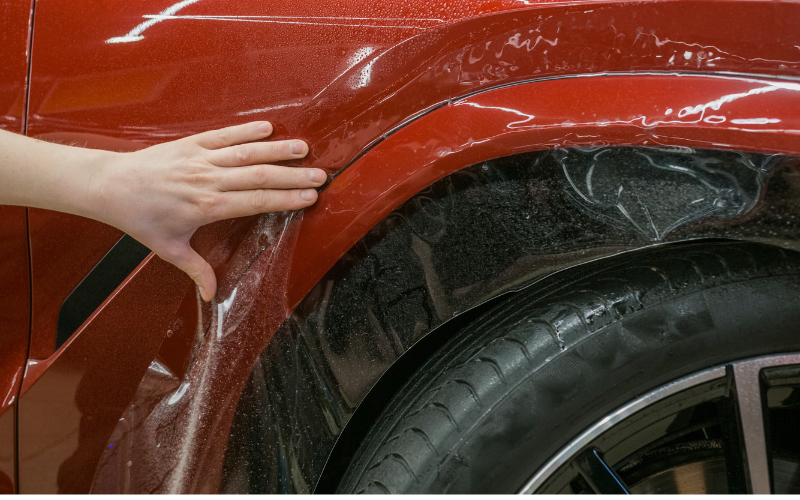
How Does a Paint Protection Film Enhance Car Paint?
Paint Protection Film (PPF) acts like a shield for your car’s paint, guarding against rock chips and scratches that everyday driving can cause. The film’s advanced technology provides a barrier that is tough on impacts but gentle on your car’s finish.
This kind of protection ensures your vehicle looks newer for longer by preserving the integrity and beauty of the paintwork.
PPF ceramic coating brings an extra layer of resilience against harsh elements.
Moreover, PPF comes equipped with self-healing technology, meaning minor scratches can disappear with heat exposure from the sun or engine warmth. It also blocks harmful UV rays, preventing the paint from fading over time.
These benefits make Paint Protection Films a smart choice for keeping your vehicle in top-notch condition while enhancing its overall appearance and value.
Protection Against Rock Chips and Scratches
Paint Protection Film (PPF) acts as a barrier against rock chips and scratches, which can harm the vehicle’s paint. Driving exposes your car to flying debris that can damage the clear coat and underlying color.
Applying PPF provides a layer of protection that keeps these imperfections at bay.
This film also contributes to maintaining the vehicle’s aesthetic value over time. Thanks to its self-healing technology, minor scratches disappear with heat exposure, such as sunlight or warm water.
Consequently, vehicles equipped with both ceramic coating and PPF enjoy longer-lasting protection and an enhanced gloss finish, making them more straightforward to clean and maintain their shine even in challenging environments.
Benefits of Self-Healing Technology
Self-healing technology in paint protection films (PPF) revolutionizes how vehicles maintain their showroom shine. This innovative feature enables the film to self-repair minor scratches, and swirl marks can fade when exposed to heat, like sunlight or warm water.
Vehicle owners find this aspect particularly beneficial because it significantly reduces the cost of paint protection efforts over time. The PPF acts as a shield, guarding against everyday wear and tear that every vehicle faces.
The effectiveness of self-healing technology ensures cars, bikes, and other vehicles look newer and longer without regular trips to a detailing service. Imagine driving your vehicle on a sunny day and watching those annoying fine lines disappear, almost like magic.
It’s not just about aesthetics; this technology also contributes to maintaining the vehicle’s resale value by keeping the exterior in excellent condition. With features similar to PPF and benefits that extend beyond surface-level protection, self-healing tech offers an advanced solution for car enthusiasts seeking the best protection options for their prized possessions.
Effectiveness in Blocking UV Rays
Shifting from self-healing technology, paint protection films and ceramic coatings play a crucial role in blocking UV rays. These protective layers act as a shield for the vehicle’s paint.
They prevent the sun’s harmful ultraviolet rays from fading the car’s color. Over time, exposure to sunlight can make vibrant colors look dull and old. Paint Protection Films (PPF) and ceramic coatings preserve the gloss and hues of the vehicle’s exterior.
These products offer more than just physical protection; they extend the life of your car’s paint job by preventing UV-induced degradation. A car that is often parked outside experiences direct sunlight for hours, leading to potential damage.
Applying PPF or getting a ceramic coated surface helps maintain your vehicle’s appearance and value over time. This makes them an essential addition for any new vehicle or regular car looking to withstand the harshness of sun exposure without compromising its aesthetics.
Is PPF and Ceramic Coating a Good Combination?
PPF and ceramic coating deliver dual defense lines for your vehicle. Paint Protection Film, or PPF, operates as a clear protective cover that guards the paint from rock chip damage and scrapes.
On the other hand, ceramic coating administers a water-repelling layer causing water droplets to gather and roll off, resulting in a cleaner car for extended periods. Car care professionals suggest that the combination of these two results in an effect where their advantages are mutually beneficial.
Integrating PPF with ceramic bonds provides unparalleled protection and glow for vehicles.
This mix enhances the shine of your car’s exterior while also simplifying upkeep. PPF’s self-repair function works autonomously to fix minor scratch damage, while the hardness of ceramic coatings gives an added durability layer against chemical stains and etchings.
Car owners find this pair beneficial as it extends the time it takes for their vehicles to maintain their immaculate appearance while reducing the frequency and ease of cleaning tasks.
Exploring the Synergy of Protection Films and Ceramic Coatings
In unison, protective films like PPF and ceramic coatings create a potent defense for the vehicle’s paint. The PPF, also called a clear bra, offers a protective layer that effectively safeguards against rock chips and scratches.
Concurrently, ceramic coating contributes an extra barrier. This alliance guarantees your car encounters fewer damages from daily hazards. It further simplifies cleaning as dirt and grime are less likely to adhere.
Ceramic coatings enhance this interaction by causing surfaces to be water-repellent, resulting in water easily forming beads and rolling off. Vehicles treated with both PPF and ceramic coatings maintain their shine for extended periods and exhibit increased resistance against UV rays.
This twofold strategy maintains cars in pristine condition and helps preserve their value over time. Owners find that their upkeep tasks are lessened owing to the self-repairing qualities of contemporary PPF and the durability that ceramic coatings introduce.
Enhancing Gloss and Hydrophobic Properties
Combining PPF and ceramic coating offers your vehicle exceptional protection and significantly improves its visual aesthetics. The ceramic coating shines with a high-gloss finish that intensifies the car’s paint color.
The protective coating enhances the appearance and also serves as a barrier against various contaminants, ensuring the color stays vibrant and with depth over time. Ceramic coatings are hydrophobic, offering an effortless water-repellent feature.
Water forms into droplets and moves off the surface, taking dirt and grime with it.
This water-resistant feature ensures that the vehicle’s cleaning process is simplified, retaining its immaculate look with less effort. Dirt and road salts struggle to adhere to the coated surface, reducing the need for frequent cleaning and maintaining the vehicle’s visual appearance for longer.
Used in conjunction with WPPF’s self-healing technology, this combination serves as an effective defense against scratches while helping vehicles retain their just-out-of-the-showroom look.
Paint protection options like these safeguard your investment as well as keep it looking strikingly good on the road.
Making Your Vehicle Easier to Clean
After enhancing your vehicle’s shine and water-resistance with ceramic coating you’ll discover that it’s much simpler to maintain cleanliness. A vehicle treated with premier ceramic coating is water-resistant, which results in adequate water runoff from its surface.
Water spots are lessened due to this, and it also discourages dirt and filth from adhering to your car’s exterior. Consequently, regular cleaning becomes quicker and less laborious.
The application of a protective duo of Paint Protection Film (PPF) and ceramic coating grants an extra shield of protection that further eases maintenance. Particles of dust, dirt, or pollution find it challenging to stick to the vehicle’s paint owing to the smoothness rendered by these defensive layers.
The frequency of washing reduces as dirt is effortlessly rinsed away, with little scrubbing needed during each cleanse. This approach prolongs the durability of the vehicle’s paint job while ensuring it maintains a fresh appearance longer without continuous maintenance.
How to Protect Your Car with Ceramic Coating and PPF?
Protecting your car with ceramic coating and Paint Protection Film (PPF) is a wise choice to shield it against environmental hazards. Both solutions offer unique benefits and can be combined for ultimate protection.
- Start with paint correction before applying any protective layer. This process removes imperfections from the vehicle’s paint, providing a smooth surface.
- Choose the right PPF for areas most exposed to damage like the front bumper, hood, and side mirrors. This film protects against rock chips and scratches.
- Apply a ceramic coating to the entire vehicle once PPF is in place. Ceramic coating provides a liquid polymer layer that bonds with the paint, making it hydrophobic and easier to clean.
- Ensure proper curing time for both products. PPF typically requires 24-48 hours, whereas ceramic coating lasts up to 3-4 weeks for complete hardness.
- Regular maintenance keeps both layers effective. Wash your vehicle every two weeks and avoid harsh chemicals.
- Consider professional installation for optimal results. Experts have the tools and experience to ensure durability and effectiveness without changing the appearance of your car’s paint.
Each step ensures your vehicle remains protected under various conditions, maintaining its aesthetic appeal longer.
Moving on, let’s explore how Paint Protection Film specifically enhances car paint durability and appearance.
Importance of Paint Correction Before Application
Ensuring paint correction before applying the ceramic coating and PPF plays a critical role in achieving a perfectly smooth surface for the automobile’s paintwork. This procedure effectively removes any surface flaws, such as swirl marks, scratches, or oxidation, which could otherwise impact the final look and performance of the protective layers.
Through careful polishing of the exterior, you establish optimal bonding between the ceramic coating and your car’s paint, thus enhancing its water-repelling properties and durability.
This method provides an ideal foundation for Paint Protection Film to firmly adhere to, which increases its lifespan and improves its protective capabilities.
Opting for paint correction initially aids in securing your investments in both PPF and ceramic coatings. The transparent bra adheres more effectively to a rectified surface, which helps prevent potential peeling or bubbling problems in the future.
Thorough preparation of your automobile enhances its sheen and heightens its resistance to environmental contaminants. The application of these protective films on a well-prepared surface results in premier results from your vehicle detailing efforts, hence maintaining the vehicle’s fresh appearance for an extended period with minimal need for regular touch-ups.
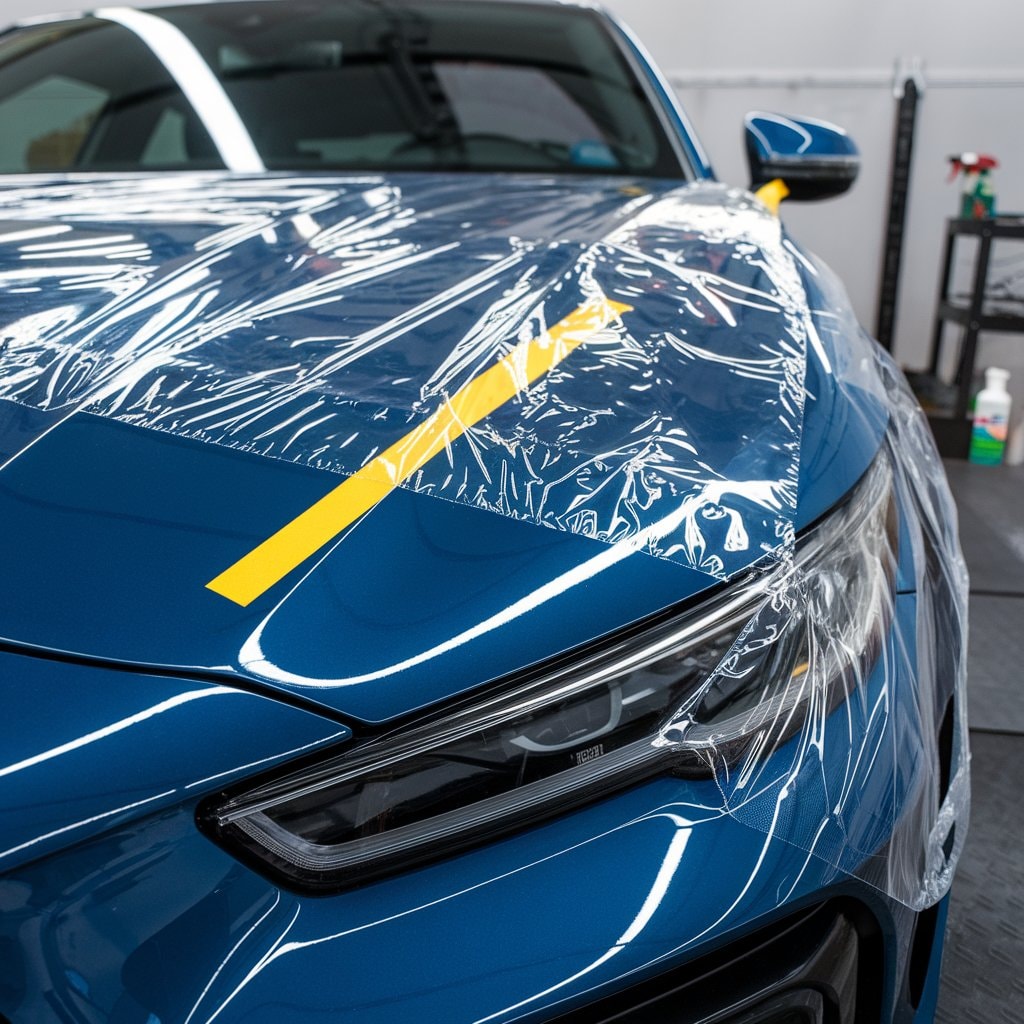
Choosing Between PPF Ceramic Coating and Clear Bra
After ensuring the paint is corrected and flawless, the next step involves deciding on the best protective coating. Two popular options are PPF (Paint Protection Film) and ceramic coating, alongside the traditional clear bra. Each offers distinct advantages, and selecting the right one depends on your individual needs and preferences.
| Feature | PPF (Paint Protection Film) | Ceramic Coating | Clear Bra |
|---|---|---|---|
| Protection Level | High – against physical damages like rock chips and scratches | Medium – mainly against chemical damages and UV rays | High – similar to PPF, protects against physical damages |
| Self-Healing Technology | Yes – minor scratches can disappear with heat application | No – does not have self-healing properties | Varies – some modern clear bras have self-healing capabilities |
| Durability | 5-7 years, depending on maintenance | 2-5 years, may need reapplication for optimum protection | 5-7 years, similar to PPF but depends on product quality |
| Gloss and Shine | Matte or gloss finishes available, enhances paint vibrancy | High gloss finish, offers a noticeable shine | Gloss finish, similar to PPF but may not enhance vibrancy as much |
| Hydrophobic Properties | Minimal – mainly protects against physical damage | High – water and dirt repel off the surface easily | Minimal – protection focused more on physical damage |
| Application Process | Complex – requires professional installation for best results | Less complex but still needs professional application for durability | Complex – similar to PPF, professional installation recommended |
Selecting the proper protection for your vehicle involves comparing these aspects. PPF and clear bra excel in physical damage protection, with some options featuring self-healing technology. Ceramic coatings stand out for their hydrophobic properties and ease of cleaning, offering a high gloss finish that enhances the vehicle’s appearance. Ultimately, the choice should align with your vehicle’s needs, considering factors like exposure to elements and daily usage patterns.
Getting the Best Out of Your Car Detailing Efforts
In maximizing the outcomes of your car detailing ventures, centering your attention on both ceramic coating and paint protection film (PPF) is crucial. Ceramic coatings provide a water-repellent layer that defends your car’s paint from pollutants, making sure it remains clean for extended periods.
This feature simplifies the upkeep of your car’s visual charm. Conversely, PPF serves as a physical defense against rock chips, scrapes, and UV rays and is equipped with self-repairing technology that mends minor scrapes almost instantaneously.
Selecting from PPF, ceramic coating, or clear bra is reliant on your expectations for the vehicle’s longevity and aesthetic alterations. For top-tier protection, specialists recommend first applying a ceramic coating to profit from its water-repellent properties.
Subsequently, PPF should be added to high-risk areas like the front bumper, hood, and side mirrors to defend against physical damage. Combined, they guarantee your vehicle maintains its impressive appearance and is also safeguarded from both natural factors and everyday deterioration.
Conclusion
Preserving your vehicle’s paintwork goes beyond maintaining its shine; it’s a wise decision to maintain its value and look. The combination of Paint Protection Film (PPF) and ceramic coating offers unmatched protection against rock chips, scratches and damaging UV rays from the sun.
These two work in unison to ensure your car remains water-repellent, simplifying its cleaning and enhancing its shine. Requesting a quote for these services can be the initial step in providing enduring safety for your vehicle.
Vehicle owners who adopt this approach have the satisfaction of knowing their vehicle is aesthetically pleasing and defended against environmental elements that can alter its look over time, including the rocker panels, which are particularly vulnerable to damage from road debris and weathering.
Selecting between PPF, ceramic coating, or both, rests on your vehicle’s usage and the kind of defense you prioritize. For those desiring the utmost hearty and efficient car paint protection, discussing with experts like Esperto Car Care Coimbatore can ease the decision-making process.
They offer professional advice and apply protective coating products to guard vehicles against everyday damage. Making the correct decision would assist in keeping the vehicle’s visual charm while shielding its exterior for the coming years.

